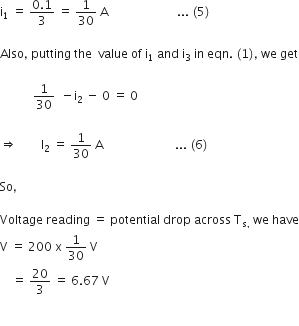 Short Answer Type
Short Answer Type
In fig given above, the parallel combination of resistance of 400 Ω and voltameter (V) of resistance 400 Ω connected across it. The equivalent resistance is 200 Ω. Then in given circuit is equivalent.
(i) Applying Kirchhoff's second law in closed loop OPLMN
100i2 - 1OOi1 + 100i3 = 0
i2 - i 1+ i3 = 0
⇒ - i1 + i2 + i 3 = 0
or - I (i 1- i2-i3) = 0 ...(1)
(ii) In closed loop (ii) OPQRLPO, we have Kirchhoff' s second law,
lOOi 1+ (i1 + i 3)200 = 10
or 100i1 + 200i1 + 200i3 = 10
⇒ 300i 1+ 200i3 = 10
3i1 + 2i3 = 0.1 ...(2)
(iii) In closed loop (iii), MTSRLM, according Kirchhoff s second law
(i2 -i3) 200 - (i1 + i3)200 - lOOi3 = 0
or 200i2 - 200i3 - 200i1 - 200i3 - 100i3 = 0
200i2 - 200i1 - 500i 5 = 0
or -200i1 + 200i2 - 500i3 = 0
or i1-i2 + 2.5i3 =0 ...(3)
From eqn. (1) and (3), we get
(i 1- i2 - i3 ) - (i 1- i2 + 2.5i3 )=0
⇒ i 1- i2 - i3 -i 1+ i 2- 2.5i3 = 0
-3.5 i3 = 0
or i3 = 0 ...(4)
Putting value i3 in eqn. (2), we get
3i1 + 2 x 0 = 0.1
3i 1 =0.1
What type of wave front is produced by:
(i) Point source of light (ii) Line source of light

A fish is located at a distance of 10 cm from the wall of a fish pond. The thickness of the glass wall is 2 cm. Find the apparent position of the fish. (Given
aμg = 3/2 and aμw= 4/3)
